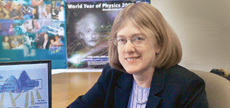 Photo: Brookhaven National Laboratory |
Commentary: Sally Dawson
Prioritizing our scientific questions
We are at a special time in particle physics. The past decade has been full of discoveries. Not only have we discovered the top quark and completed a spectacular series of measurements verifying the validity of our understanding of the theoretical framework of particle physics, but we have uncovered a series of surprises. Ten years ago, only the very brave dared speculate that neutrinos had mass, and the idea that the universe was predominantly made of dark energy was preposterous.
|
||||
We are approaching a new decade of discovery with the start-up of the Large Hadron Collider. The missing ingredient in our particle zoo, the Higgs boson, will certainly be uncovered at the LHC if it exists with the expected properties. Fifteen years ago, I was a young post-doc during the beginning of the Superconducting Supercollider construction, and I wondered whether there was a light Higgs boson or if supersymmetric particles existed at the TeV energy scale. These are still among the most pressing questions for particle physicists, and it is tremendously exciting to realize that we will soon know the answers. And physicists being physicists, ever curious about our universe, the discovery of a light Higgs boson or of a supersymmetric particle will lead to more questions: Are there more dimensions than the ones we observe? Are the forces unified at some very high energy scale? The list of questions is endless. The more we know, the more we wonder.
We have the experimental tools and technologies to address many of these questions. Answering them, however, requires ever more powerful experiments and accelerators and leads physicists to dream of an International Linear Collider. At the same time, much of the success of our field is due to the diversity of experiments; both in the scale of experiment and in the scientific motivations. The realization of our dreams requires new mechanisms for approaching future facilities in a truly global way, with scientific priorities set in an international framework. This challenges particle physicists to think about the future in different ways from in the past.
The National Research Council of the National Academies has formed a committee, Elementary Particle Physics in the 21st Century, dubbed "EPP2010", with the charge of prioritizing the scientific questions of particle physics. This study is charged to "Identify, articulate, and prioritize the scientific questions and opportunities that define elementary particle physics and recommend a 15-year implementation plan with realistic, ordered priorities." (See charge online). This is a tall order, but the committee is fortunate to have Harold Shapiro, the president emeritus of Princeton, as chair, with a distinguished roster of members, including three Nobel Prize winners. The committee is unusual in that half the members are not particle physicists. It is an exciting challenge to articulate to this committee the questions and excitement of particle physics and to help the committee find a way to think about how to do the most physics given a limited budget. I feel privileged to be a part of this grand enterprise.
Sally Dawson is a physicist in the High Energy Theory group at Brookhaven National Laboratory. She served as group leader from 1998 to 2004, and is now the acting chair of the BNL Physics Department. Since 2004 she has been a member of the International Committee for Future Accelerators. She is the vice chair of the National Research Council committee EPP2010: Elementary Particle Physics in the 21st century.
Click here to download the pdf version of this article.


